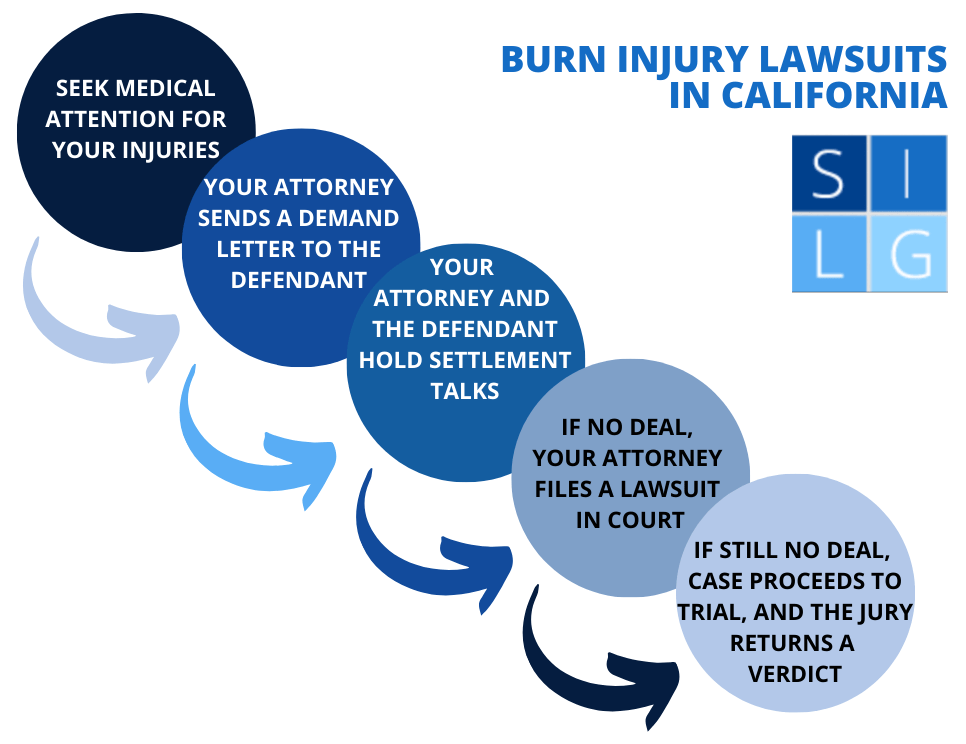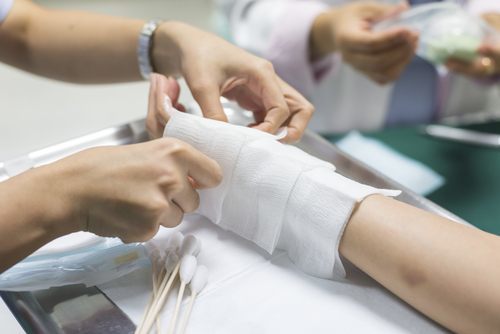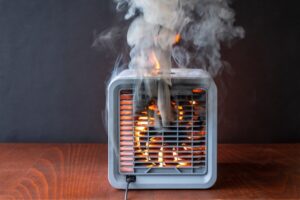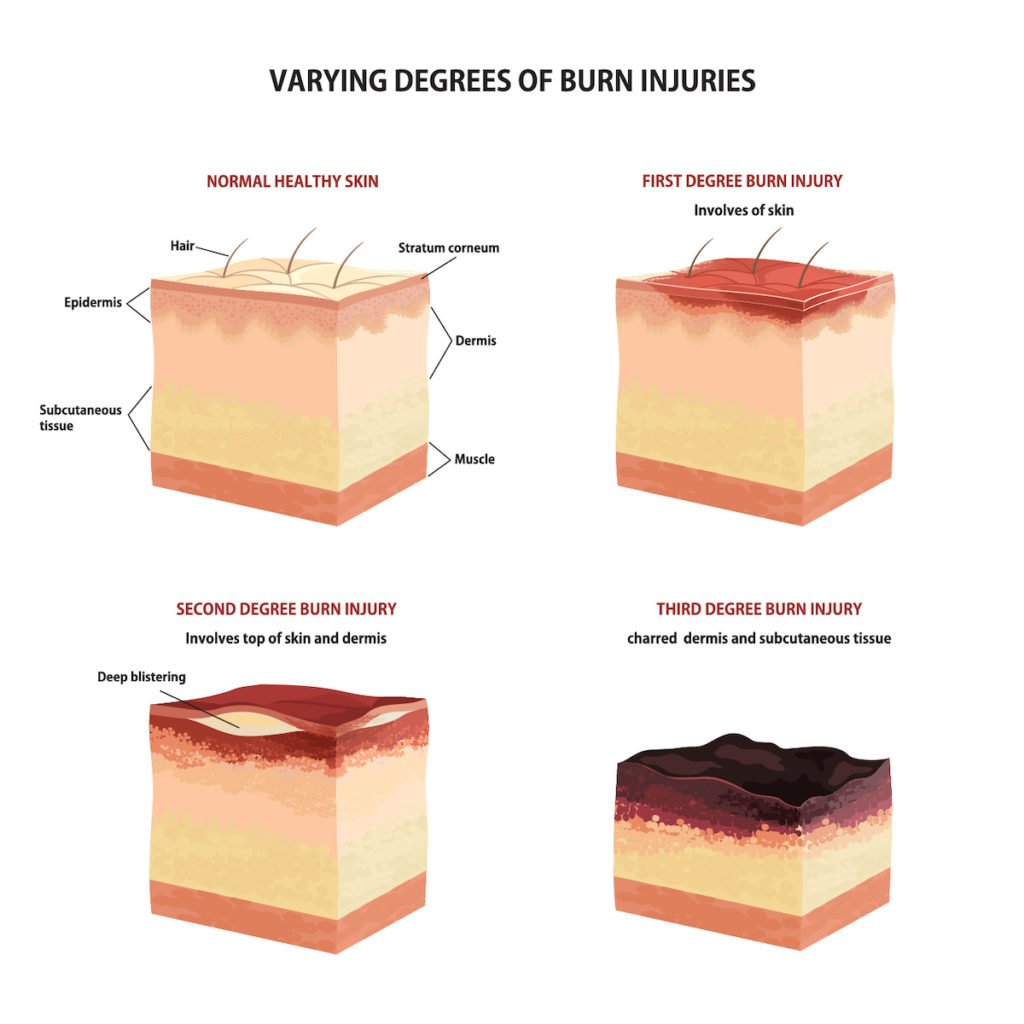Burn injuries can be caused by product defects, workplace injuries, or another person’s negligence. The person or company responsible for the burn injury is liable to you for damages. Even if you were partially to blame for the accident, you could be awarded partial damages based on the defendant’s level of fault.
The compensation for a burn injury can include damages for the loss of a job, medical bills, and continuing medical care. A personal injury lawsuit can help you and your family recover damages, including:
Common causes of burn injuries include:
- Construction site accidents,
- Vehicle accidents,
- Fireworks accidents,
- Kitchen accidents,
- Scalding water,
- Electric shock accidents,
- Tanning bed burns, and
- Chemical burns.

Below, our California burn injury lawyers discuss the following frequently asked questions about burn injury lawsuits:
- 1. Burn injury lawsuits?
- 2. Financial compensation
- 3. Wrongful death
- 4. Treatment and costs
- 5. Burn injuries at work
- 6. Types of burns
- 7. Statute of limitations
- Additional reading
If you have further questions about burn injury cases after reading this article, we invite you to contact us at Shouse Law Group.
1. Burn injury lawsuits
A personal injury lawsuit allows you to seek money damages for physical injuries and financial losses. Burn injury lawsuits are generally based on:
- Negligence,
- Product Defects, or
- Premises Liability.
You and your family can file a personal injury lawsuit in civil court. However, there is a time limit to how long you have to file a claim.

The person or company responsible for the burn injury is liable to the victim for damages.
Based on negligence
Negligence is the wrongful actions (or inaction) of an individual, group, or company that causes harm to another. You have to prove the following elements to win a personal injury case based on negligence:
- The defendant owed you a duty of care;
- The defendant breached that duty; and
- The defendant’s breach was a substantial factor in causing your harm.12
Example: Rick throws some firecrackers into the air, which sets Liz’s hair on fire. Liz may be able to file a personal injury claim against Rick: He was negligent by throwing firecrackers while people were nearby.
Under California’s “comparative fault” laws, you can still recover partial damages even if you were partly to blame for the accident. Your damages are reduced by your own share of the fault, and the defendants are liable for the remaining portion of damages.3
Based on a defective product
When a defective product causes your burn injury, the company that produced or sold the product may be liable for damages, even if no individual person was negligent. Under most state product liability laws, whoever designs, manufactures, or sells a defective product is strictly liable for any injuries caused by the product.4
Strict liability cases can include the following types of product defects:
In a product liability lawsuit for burn injuries, you have to prove:
- The defendant designed, manufactured, distributed, or sold the defective product;
- The product contained a manufacturing, design, or warning defect when it left the defendant’s possession;
- You used the product in a reasonably foreseeable way; and
- The product defect was a substantial factor in causing your harm.5
Example: Lucien was using his hoverboard when it suddenly burst into flames. He can file a product liability lawsuit against the manufacturer and seller. Lucien can win even if the defendants did not know the hoverboard was defective.
Based on premises liability
If your burn accident happens on another person’s property, the property owner may be liable for damages if your burn injury was caused by a hazard on the property. Under premises liability laws, property owners and occupiers have to keep the property in a reasonably safe condition.
Property owners have a duty of care to inspect and maintain their property, repair dangerous conditions, and/or give warnings about any dangerous conditions.6
Example: Madeleine kept her backyard hot tub really hot. At Madeleine’s invitation, her friend went in the tub and then sustained scalding burns. Unless Madeline warned her friend ahead of time about the temperature, her friend can sue Madeleine since the tub was on Madeleine’s property.

Manufacturers have strict liability for their defective products.
2. Financial compensation
In a personal injury lawsuit, you are looking for money to pay for your damages caused by the accident. These are known as “compensatory damages.” Compensatory damages are supposed to compensate you for economic and non-economic damages.
In some cases, you can also sue for punitive damages. Punitive damages, or “exemplary damages,” are intended to punish the wrongdoer. However, punitive damages are generally limited to cases where the defendant’s actions were:
- Extremely reckless,
- Malicious,
- Oppressive,
- Fraudulent, or
- Intended to cause harm.7
Economic damages
Economic damages include out-of-pocket costs, money you have spent, or money you will have to pay out in the future. In a burn injury accident, economic damages may include:
- Medical bills,
- Surgery,
- Burn unit treatment,
- Skin grafting procedures,
- Lost wages,
- Lost earning capacity, and
- Property damage.
Non-economic damages
Non-economic damages may be more difficult to quantify but are still part of your damages after an accident. This can include money damages to cover your losses for:
- Emotional distress,
- Disfigurement,
- Physical impairment,
- Scarring,
- Pain and suffering,
- Loss of enjoyment in life, and
- Loss of consortium.
How are damages calculated?
Damages in a lawsuit may be decided by the judge or jury. The factfinder looks at the claimed damages and makes a determination on how much you should receive. Past economic damages can be calculated by looking at medical bills, financial records, and repair costs.
Economic damages also include future expenses. In these situations, a burn injury attorney may hire an expert to submit a report and testify about the likely future costs to you for things like:
- Future medical treatment,
- In-home care estimates,
- Insurance payments and coverage, and
- How much you would have earned if you were not injured in the accident.
3. Wrongful death
If your family member is killed in a fire or burn injury accident, you may be able to file a wrongful death lawsuit. A wrongful death lawsuit will allow you to recover damages and hold the wrongdoer responsible for their actions.8
In most cases, eligible family members who can file a wrongful death lawsuit include:
- Spouses;
- Domestic partners;
- Children;
- Grandchildren (if the children are deceased); or
- Anyone else entitled to the property of the decedent by California intestate succession laws.
The money damages available in a wrongful death lawsuit include:
- Funeral expenses,
- Burial expenses,
- Loss of services the deceased would have provided,
- Loss of companionship, and
- Loss of financial support the deceased would have provided.9
4. Treatment and costs
According to the Centers for Disease Control and Prevention (CDC), in 2011, there were nearly 486,000 burn injuries that received medical treatment. Over 3,000 people died in the U.S. in 2011 because of residential and vehicle fires, including deaths from smoke inhalation.10
The causes of most of these burn injuries were an open flame, scalding liquid, contact burns, electrical burns, or chemical burns. Almost three-fourths of the burn injuries occurred in the home.11
Moderate burn injuries can cost more than $200,000. Severe burn injuries can cost more than $1.5 million. If there are complications, a severe burn injury can cost more than $10 million.
Burn injuries can cause serious damage and require extensive medical treatment. Many patients require special treatment in a specialized burn unit. With serious burn injuries, there is an increased risk of complications, including:
- Psychological complications,
- Disfigurement,
- Skin breakdown,
- Infections, and
- Skin graft failure.
5. Burn injuries at work
If you are injured on the job, recovery is generally handled through filing a workers’ compensation claim. With workers’ comp, you do not have to file a lawsuit or prove negligence.
Workers’ comp is a type of no-fault insurance that pays for your medical costs and provides partial wage replacement. However, other non-economic damages are generally not available.
In some cases, you may be able to file a personal injury lawsuit if the accident is:
- Caused by a third-party;
- Caused by intentional action to harm you;
- Aggravated by something the employer fraudulently conceals; or
- The employer does not have workers’ compensation insurance at the time of the accident.

Generally, the more serious the burn, the higher the settlement.
Types of burns
The following are the main types of burns:
- Chemical burns (also called “caustic burns”) arise from corrosive chemicals and acids like chlorine and battery acid.
- Electrical burns result from charged metals and wiring and high voltage shocks.
- Inhalation burns are from breathing in smoke (which can hurt your eyes and lungs).
- Radiation burns, which commonly result from tanning beds or lasers.
- Scalds, which arise from hot liquids or steam.
- Thermal burns, which come from direct contact with hot surfaces or open flames.
If only the top layer of skin is affected, the burn is classified as first degree. Even though they will heal without medical attention, they are still painful and can manifest as red, inflamed, and swollen skin.
If both your epidermis (upper layer) and dermis (lower layer) are affected, the injury is a second degree burn. Blistering and scarring is common, and you usually need to see a doctor.
Burns that reach underlying tissue and muscles are third degree burns. While the wound is open, you risk infection and sepsis. Doctors may try to treat the burn with a skin graft that will require long-term wound care, and you will likely be prescribed sulfadiazine, tetanus shots and/or antibiotics.
Fourth degree burn reach the organs and bones and can be fatal. Ironically the most serious burns often hurt the least because your nerve endings are damaged. They also result in permanent disfigurement.12
7. Statute of limitations
In California, you generally have two years after your burn injury accident to bring a personal injury lawsuit. Though if you are suing the government, you have only six months.
After the deadline passes, you may no longer be able to recover damages. However, the statute of limitations can be paused (“tolled”) in some cases, such as if the victim is under 18 years old.13
Additional reading
For more in-depth information, refer to these scholarly articles:
- Surgical Fires and Operative Burns: Lessons Learned From a 33-Year Review of Medical Litigation – The American Journal of Surgery.
- Burn injury: economic and social impact on a family – Public Health.
- The McDonald’s Coffee Lawsuit – Journal of Consumer & Commercial Law.
- Defending the Catastrophic Burn Injury Case – Annual Quality Congress Proceedings; Milwaukee.
- Radiation Injuries and Statistics: The Need for a New Approach to Injury Litigation – Michigan Law Journal.
Legal References:
- California Civil Code Section 1714(a) (“Everyone is responsible, not only for the result of his or her willful acts, but also for an injury occasioned to another by his or her want of ordinary care or skill in the management of his or her property or person.”)
- California Civil Jury Instructions (CACI) 400. Negligence — Essential Factual Elements.
- California Civil Jury Instructions (CACI) 405. See also California Civil Jury Instructions (CACI) 406. (“… you must then decide how much responsibility each has by assigning percentages of responsibility to each person listed on the verdict form. The percentages must total 100 percent.”).
- Soule v. GM Corp. (1994) 8 Cal.4th 548, 560 (“A manufacturer, distributor, or retailer is liable in tort if a defect in the manufacture or design of its product causes injury while the product is being used in a reasonably foreseeable way.”)
- California Civil Jury Instructions (CACI) Series 1200 — Products Liability.
- California Civil Jury Instructions (CACI) (2017) 1000. Premises Liability. Essential Factual Elements. See also Sprecher v. Adamson Companies (1981) 30 Cal.3d 358.
- California Civil Code Section 3294 — Exemplary Damages. ((a)” In an action for the breach of an obligation not arising from contract, where it is proven by clear and convincing evidence that the defendant has been guilty of oppression, fraud, or malice, the plaintiff, in addition to the actual damages, may recover damages for the sake of example and by way of punishing the defendant.”)
- California Code of Civil Procedure 377.60 (“A cause of action for the death of a person caused by the wrongful act or neglect of another may be asserted by any of the following persons or by the decedent’s personal representative on their behalf: (a) The decedent’s surviving spouse, domestic partner, children, and issue of deceased children, or, if there is no surviving issue of the decedent, the persons, including the surviving spouse or domestic partner, who would be entitled to the property of the decedent by intestate succession.”)
- California Civil Jury Instructions (CACI) 3921. See also Vander Lind v. Superior Court (1983) 146 Cal.App.3d 358; and Allen v. Toledo (1980) 109 Cal.App.3d 415.
- American Burn Association — Burn Incidence Fact Sheet.
- Same.
- Same.
- California Code of Civil Procedure §335.1. CCP § 352(a). CCP § 341.
